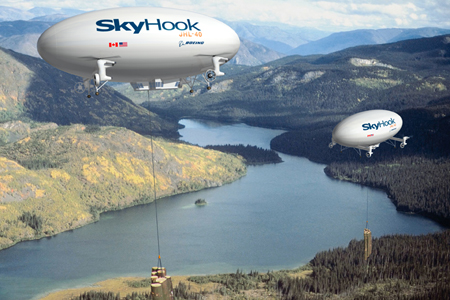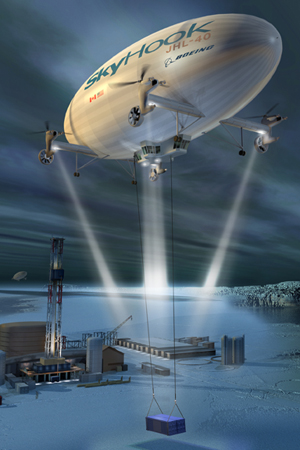Boeing-SkyHook JV to develop hybrid rotorcraft/airship – heavy lifter will carry 40 tons
09 Jul 2008
Boeing's defence division and Canadian start-up SkyHook International have announced a five-year-plan to develop and produce a hybrid rotorcraft/airship that can lift a 40 tons payload to a distance of 200 miles.
The so-called Jess Heavy Lifter, or JHL-40, is launched to service a niche market of commercial oil and mining companies operating in Canada's far north. The joint venture will also consider a US Army requirement for development by 2015 of a heavy-lift rotorcraft capable of lifting at least 30 tons.
The JHL-40 takes its first name from the SkyHook founder, Peter Jess.

The Boeing/SkyHook team estimates a potential commercial market of about 60 aircraft.
It also hopes to offset high upfront costs, involved in launching a new product, by leveraging Boeing's existing technology. The JHL-40, designed by Peter Jess, will leverage rotor technology from Boeing's CH-47 Chinook and avionics and flight control technology from the under construction 787 Dreamliner. It will also benefit from Boeing's experience as a lead systems integrator. ''If you have to develop all of that technology from scratch on this aircraft we wouldn't be sitting here today,'' said Pat Donnelly, Boeing's director of advanced rotor systems.
The Boeing/SkyHook team will seek to learn its lessons from pioneering aviation firm Piasecki Aircraft's failed attempt to develop a similar, quad-rotor heli-stat. The PA-97 prototype, used a Navy ZPG-2W blimp and four H-34J helicopters. It was cancelled after crashing in 1986. Boeing is the inheritor of the company founded by helicopter pioneer Frank Piasecki.

Boeing's review of Piasecki's records attributed the crash to an aerodynamic phenomenon called ''dynamic resonance.'' ''We are experts in dynamic reactions,'' Donnelly said. ''Helicopters are a million pieces trying to shake themselves apart.''
The design of the SkyHook is intended to be ''neutrally buoyant,'' meaning the helium-filled envelope will be able to lift the empty weight of the aircraft. It's four rotors, which generate 21,000shp, will be used to lift a 40 ton payload. The advantage of such a design becomes evident when compared with that of the world's largest helicopter – Russia's Mi-26. The Mi-26 must lift both its own empty weight and payload and it needs approximately 22,000shp to lift a 20 ton payload.
The JHL-40 will be powered by four sets of lifters and thrusters. The thrusters will generate a total of about 7,000 to 8,000lb-thrust to maintain aircraft stability.
The JHL-40 is also environmentally acceptable because it mitigates the impact of building new roadways in remote areas, and Skyhook is expected to reduce the carbon footprint of the industrial projects it supports.






























